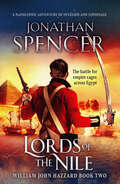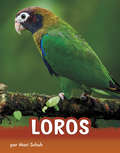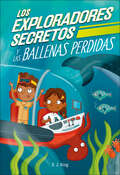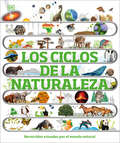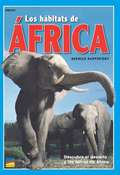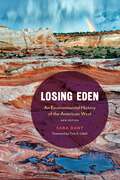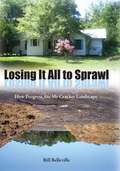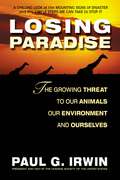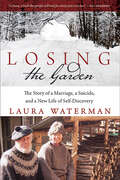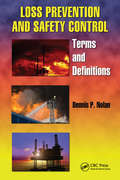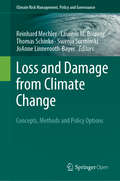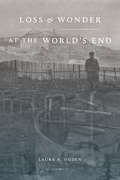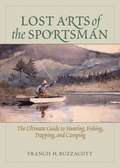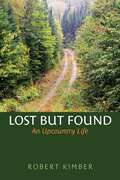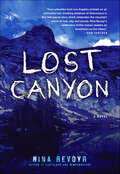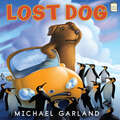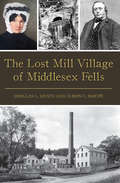- Table View
- List View
Lords of the Nile: An epic Napoleonic adventure of invasion and espionage (William John Hazzard series)
by Jonathan SpencerThe battle for Empire rages across EgyptThe thrilling second novel in the William John Hazzard series, following Napoleon's Run.Malta, June 1798. Captured by the French after hurling himself into enemy ranks, Hazzard is now a prisoner of his arch-nemesis, spycatcher Citizen Derrien, but has uncovered the true purpose of Napoleon’s armada: the conquest of Egypt. Their bold plan is to cut open the ancient Suez Canal to the Red Sea and attack India, the jewel in England’s crown. The survival of nations in the balance, Nelson scours the Mediterranean for the French in vain. If Hazzard can’t convince Admiralty Intelligence of a desperate plan, an ancient world will be lost for ever. But help comes from an unexpected quarter: the missing Admiralty agent…As French cannons roar in the desert sands and the Mamluk cavalry sweeps in to attack, Hazzard fights to prevent a lost cause turning into tragedy.From the shores of Malta to the epic encounter at the Battle of the Nile – this is the explosive beginning of the French conquest of Egypt. Never give up the boat.Praise for Jonathan Spencer‘Stupendous... Lords of the Nile has such a breathtakingly frenetic plot that I found myself getting faster and faster in my reading, tearing through the pages, only to realise that I was trying to match the pace of the characters and the plot. It is so immersive you can’t help but be sucked into it, swept away by it, pushed to tears by it and utterly enthralled by it.‘Jonathan Spencer is now one of my “Must read” authors, a drop-what-you’re-doing-(or whatever else you are reading)-and-read-it-now writer. My favourite book this year.’ Parmenion Books on Lords of the Nile‘This is an outstanding novel, made even more remarkable by its début status. Better than Sharpe, gripping and intense, Napoleon’s Run deserves to be a runaway success’ Ben Kane, Sunday Times bestselling author of Lionheart on Napoleon's Run'Hornblower meets Mission: Impossible. A thrilling, page-turning debut packed with rousing, rip-roaring action' J. D. Davies, author of the Matthew Quinton Journals on Napoleon's Run
Lords of the Ocean: An Isaac Biddlecomb Novel (Isaac Biddlecomb Novels)
by James L. NelsonJames L. Nelson's Isaac Biddlecomb series has brought to life a never-before-seen side of America's war for independence. With the expertise of a seasoned mariner, a historian's vivid attention to detail, and a natural gift for sensational storytelling, "the American counterpart to Patrick O'Brian" (David Brink) carries us along on his bold and stirring course through history.After ferrying General George Washington's troops across the East River and through the hell known as the Battle of Long Island, Captain Isaac Biddlecomb receives a monumental order. He is to transport to France the most powerful secret weapon in the country's arsenal—scientist, philosopher, and spirit of the enlightenment Dr. Benjamin Franklin. With a new team of men forging through the wintry North Atlantic and braving the cordon of the Royal Navy, Biddlecomb's seemingly simple mission is just the first volley in a grand scheme: to topple France's neutrality by gaining its vital support, and turn the colonial uprising into a full-scale world war for freedom.
Lore of the Lumber Camps
by E. C. BeckA collection of songs/ballads and stories of the Michigan lumber camps of the 1800's.
Loros (Animals en espanol)
by Mari SchuhLos loros no solo imitan el habla humana. Estas coloridas y pi´caras aves suelen aparearse de por vida y algunas llegan a vivir ma´s de 90 an~os. Aprende ma´s sobre estas inteligentes aves.
Los Everglades (¡Arriba la Lectura!, Level Q #43)
by Mike Graf¡El Parque nacional de los Everglades es un lugar asombroso! Esta inmensa región de agua y hierbas de Florida es hogar de muchos animales y plantas especiales. Se hizo parque nacional para proteger su hábitat sin igual. ¡Descubre lo que se puede ver y hacer en los Everglades! NIMAC-sourced textbook
Los Everglades de la Florida (¡Arriba la Lectura!, Level K #2)
by Kristin Cashore Denny BondNIMAC-sourced textbook
Los Exploradores Secretos y las ballenas perdidas (The Secret Explorers)
by SJ KingSumérgete en el mundo de los exploradores secretos y aprende sobre la vida oceánica en esta trepidante primera entrega de una nueva serie de ficción.¡Conoce a los exploradores secretos! Son un grupo de niños brillantes de alrededor del mundo dispuestos a solucionar problemas, resolver misterios y reunir conocimiento por todo el planeta... y más allá. Siempre que se necesite su ayuda, aparecerá un letrero especial en una puerta. Atraviesan la estación de exploración y reciben su misión...En Los Exploradores Secretos y las ballenas perdidas el experto en la vida marina, Connor, necesita usar su experiencia submarina para ayudar a salvar una manada de ballenas jorobadas que han perdido su rumbo. Junto con el experto en espacios Roshni, se aventuran en un submarino para encontrar un modo de ayudar a las ballenas a volver a su senda, pero por el camino se encuentra con obstáculos inesperados, como unas ballenas bebé que se han perdido o una flota de barcos. ¿Lograrán los Exploradores Secretos llevar a cabo su misión?Repleto de divertidas ilustraciones e información sobre las ballenas jorobadas, la vida marina y el impacto del cambio climático en los océanos, esta emocionante aventura es perfecta para primeros lectores. La narracción, llena de acción, atrapa la atención de los niños y les ayuda a aprender sobre lo divertido que es el mundo natural.Dive into the world of Los Exploradores Secretos and learn about ocean life in this action-packed first installment in a brand-new fiction series.Meet Los Exploradores Secretos! This group of brilliant kids comes together from all four corners of the globe to fix problems, solve mysteries, and gather knowledge all over the planet - and beyond. Whenever their help is needed, a special sign will appear on a door. They step through to the Exploration Station and receive their mission...Los Exploradores Secretos y las ballenas perdidas, marine life expert Connor needs to use his underwater expertise to help save a pod of humpback whales that have lost their way. Along with space expert Roshni, he sets out in a submarine to search for a way to steer the whales back on track, but encounters unexpected problems along the way, including lost baby whales and a fleet of boats. Will The Secret Explorers manage to succeed in their mission?Packed with fun illustrations and facts about humpback whales, marine life, and how climate change is affecting the oceans, this thrilling adventure is perfect for emerging readers. The action-packed narrative keeps kids engaged and makes learning about the natural world fun.
Los caminos más fantásticos del mundo (¡Arriba la Lectura!, Level R #56)
by Diana NoonanEl excursionismo es un pasatiempo que atrae a personas de todo el mundo. Muchos países tienen senderos famosos por su longitud, sus paisajes o su vida silvestre. ¡Lee sobre algunos de los caminos más fantásticos del mundo! NIMAC-sourced textbook
Los ciclos de la naturaleza (DK Children's Timelines)
by DKDescubre la increíble naturaleza de nuestro planeta a través de cronologías, imágenes y fotografías.Si alguna vez te preguntaste cómo será la rutina de un chimpancé, qué sucede durante las 24 horas del día en un desierto, o cuánto dura el embarazo de un canguro, este libro es para ti. Timelines of Nature te muestra la historia natural de nuestro planeta y los ciclos vitales de los seres vivos que lo habitan a través de detalladas líneas temporales y divertidos elementos visuales.En su interior, encontrarás:-Líneas de tiempo que ayudan a visualizar de forma fácil en el tiempo el desarrollo de la historia del mundo natural, desde el Big Bang y el origen de las plantas hasta la extinción de los dinosaurios.-Contenido dividido en cuatro temas principales: la Tierra, las plantas, los hongos y los animales-Esquemas y explicaciones sobre lo que sucede es el transcurso de un año en diferentes hábitats, en el ciclo vital de una planta o en el día a día de un animal.-Información y datos curiosos de los momentos y sucesos más extraordinarios de la geología, la fauna y la flora, como una mariposa saliendo de su crisálida.-Fascinantes fotografías e ilustraciones realistas de la naturaleza.¡Observa qué pasa en el planeta minuto a minuto, hora a hora y día a día en cada mes del año! Descubre cuántos años tardó la Luna en formarse, las etapas de crecimiento de diferentes animales y cómo ha evolucionado la vida desde los primeros organismos unicelulares. El recurso perfecto para estudiar biología.Discover the fascinating history of our planet with this unique collection of visual timelines.Full of exciting visual timelines covering minutes, hours, days, weeks, months, and years, Timelines of Nature reveals our planet’s natural history and its life cycles in an entirely new way. Beginning at our world’s existence; children aged 9+ will learn how many years it took the Moon to form and witness Earth’s continents collide. Discover the history of Earth’s most spectacular features – from the Grand Canyon to the Sahara desert. See how life evolved, from the first single-celled organisms to the extraordinary variety of creatures living today. Then we look at life on Earth today. Every species on Earth has its own unique story – Timelines of Nature reveals these weird and wonderful life cycles through fascinating visual timelines. It tells you what’s really happening on Earth each minute of every day. This beautiful nature book for children features:- Beautiful timelines teach young readers all about geology, plants, and animals.- Each timeline is unique and depicts a different topic, such as the story of how whales evolved, how the Moon was formed, or how a tiger spends its day.- Feature pages highlight climactic moments in nature, for example, the butterfly finally emerging from its chrysalis.- Supporting educational boxes on each page explain key points about nature, helping kids to discover more about the world around them.Children can marvel at a variety of different timeframes in nature, like geological timelines spanning thousands of years; a year in the life of a habitat, a day in the life of an animal, and complete plant life cycles.
Los viajeros y el oso (¡Arriba la Lectura!, Level M #68)
by Lynne Benton Aleksey Ivanov Olga IvanovJack y su amigo Gordon se encuentran con un oso pardo en el bosque. ¿Qué crees que pasará? NIMAC-sourced textbook
Losing Earth: A Recent History
by Nathaniel RichA Vanity Fair Best Book of the Year: “Gripping . . . revelatory . . . Climate change is a tragedy, but Rich makes clear that it is also a crime.” —The New York Times Book ReviewFinalist, PEN/E.O. Wilson Literary Science Writing AwardBy 1979, we knew nearly everything we understand today about climate change—including how to stop it. Over the next decade, a handful of scientists, politicians, and strategists, led by two unlikely heroes, risked their careers in a desperate, escalating campaign to convince the world to act before it was too late. Losing Earth is their story, and ours.The New York Times Magazine devoted an entire issue to Nathaniel Rich’s groundbreaking chronicle of that decade, which became an instant journalistic phenomenon sparking coverage and conversations around the world. Emphasizing the lives of those who grappled with the great existential threat of our age, it made vivid the moral dimensions of our shared plight.Now expanded into book form, Losing Earth tells the human story of climate change in even richer, more intimate terms. It reveals, in previously unreported detail, the birth of climate denialism and the genesis of the fossil fuel industry’s coordinated effort to thwart climate policy through misinformation, propaganda, and political influence. The book carries the story into the present day, wrestling with the long shadow of our past failures and asking crucial questions about how we make sense of our past, our future, and ourselves.Like John Hersey’s Hiroshima and Jonathan Schell’s The Fate of the Earth, Losing Earth is that rare achievement: a riveting work of dramatic history that articulates a moral framework for understanding how we got here, and how we must go forward.“Absorbing . . . a well-told tale.” —Newsday“How to explain the mess we’re in? Nathaniel Rich recounts how a crucial decade was squandered . . . an important contribution to the record of our heedless age.” —Elizabeth Kolbert, author of The Sixth Extinction
Losing Eden: An Environmental History of the American West (Environment and Region in the American West)
by Sara DantHistorical narratives often concentrate on wars and politics while omitting the central role and influence of the physical stage on which history is carried out. In Losing Eden award-winning historian Sara Dant debunks the myth of the American West as &“Eden&” and instead embraces a more realistic and complex understanding of a region that has been inhabited and altered by people for tens of thousands of years. In this lively narrative Dant discusses the key events and topics in the environmental history of the American West, from the Beringia migration, Columbian Exchange, and federal territorial acquisition to post–World War II expansion, resource exploitation, and current climate change issues. Losing Eden is structured around three important themes: balancing economic success and ecological destruction, creating and protecting public lands, and achieving sustainability. This revised and updated edition incorporates the latest science and thinking. It also features a new chapter on climate change in the American West, a larger reflection on the region&’s multicultural history, updated current events, expanded and diversified suggested readings, along with new maps and illustrations. Cohesive and compelling, Losing Eden recognizes the central role of the natural world in the history of the American West and provides important analysis on the continually evolving relationship between the land and its inhabitants.
Losing Ground: Identity and Land Loss in Coastal Louisiana
by David M. BurleyWhat is it like to lose your front porch to the ocean? To watch salt water destroy your favorite fishing holes? To see playgrounds and churches subside and succumb to brackish and rising water? The residents of coastal Louisiana know. For them hurricanes are but exclamation points in an incessant loss of coastal land now estimated to occur at a rate of at least twenty-four square miles per year. In Losing Ground, coastal Louisianans communicate the significance of place and environment. During interviews taken just before the 2005 hurricanes, they send out a plea to alleviate the damage. They speak with an urgency that exemplifies a fear of losing not just property and familiar surroundings, but their identity as well. People along Louisiana’s southeastern coast hold a deep attachment to place, and this shows in the urgency of the narratives David M. Burley collects here. The meanings that residents attribute to coastal land loss reflect a tenuous and uprooted sense of self. The process of coastal land loss and all its social components, from the familial to the political, impacts these residents’ concepts of history and the future. Burley updates many of his subjects’ narratives to reveal what has happened in the wake of the back-to-back disasters of Hurricanes Katrina and Rita.
Losing It All to Sprawl: How Progress Ate My Cracker Landscape (Florida History and Culture)
by Bill BellevilleLosing It All to Sprawl is the poignant chronicle of award-winning nature writer Bill Belleville and how he came to understand and love his historic Cracker farmhouse and "relic" neighborhood in central Florida, even as it was all wiped out from under him. Belleville's narrative is eloquent, informed, and impassioned, a saga in which tractors and backhoes trample through the woods next to his home in order to build the backbone of Florida sprawl--the mall. As heavy machinery encircles Belleville and his community--the noise growing louder and closer, displacing everything Belleville has called home for the past fifteen years--he tells a story that is much older, 10,000 years older. The story stretches back to the Timucua and the Mayaca living in harmony with Florida's environment; the conquistadors who expected much from, but also feared, this "land of flowers"; the turn-of-the-century tourists "modernizing" and "climatizing" the state; the original Cracker families who lived in Belleville's farmhouse. In stark contrast to this millennia-long transformation is the whiplash of unbridled growth and development that threatens the nearby wilderness of the Wekiva River system, consuming Belleville's home and, ultimately, his very sense of place.In Florida, one of the nation's fastest growing states (and where local and state governments encourage growth), balancing use with preservation is an uphill battle. Sprawl spreads into the countryside, consuming not just natural lands but Old Florida neighborhoods and their unique history. In Losing It All to Sprawl, Belleville accounts for the impacts--social, political, natural, personal--that a community in the crosshairs of unsustainable growth ultimately must bear, but he also offers Floridians, and anyone facing the blight of urban confusion, the hope that can be found in the rediscovery and appreciation of the natural landscape.
Losing Paradise
by Paul G. IrwinThe last decades of the twentieth century saw an unprecedented assault by humans on nature and animals throughout the world. Instead of moving toward a better world, we are now facing a tidal wave of ecological challenges that threatens to sweep away whatever progress we have achieved.In this landmark book, author Paul G. Irwin presents an alarming look at what we have done—and continue to do—to animals, to our environment, and to ourselves. Losing Paradise first examines the beliefs that lie at the core of our destructive actions—beliefs that place humans above and against nature. It then details the results of these distorted values, including the cruel treatment of animals through factory farming, hunting, and trapping, and the destruction of our environment. But while Losing Paradise shows the damage we have done, it also shows the steps we can take to build a truly humane society and reclaim our wondrous natural world. Most important, it reminds us of the paradise this earth can be for all God&’s creatures.
Losing the Garden: The Story of a Marriage, a Suicide, and a New Life of Self-Discovery (Excelsior Editions)
by Laura WatermanIn 1971, Laura and Guy Waterman left New York City for thirty-seven acres in Vermont, where they would live in a hand-built cabin without running water or electricity for the next thirty years. It was a life based largely in the nineteenth century, a life of hauling their own water and growing their own food, of lighting candles in the evening and heating their cabin with wood from the surrounding forest. Combined with the trail tending they did in the alpine zone of the White Mountains and the books they wrote about environmental stewardship, it made for a rewarding, healthy, and fruitful existence. But that was only part of their story. Guy's depression was another part, and his ultimate decision to take his own life on the wintry summit of Mount Lafayette—a decision he made with Laura's support—was the crux, a term climbers use to describe the hardest move on the climb. Being a climber herself, Laura had to confront the crux. This meant taking a close look at Guy's suicide and asking herself a hard question: How, or why, had she come to support the decision of the man she loved? In Losing the Garden, Laura Waterman comes to terms with her husband's long depression and the complex nature of a gifted, humorous man who was driven by obsession, self-absorption, and a strange lack of confidence. Her account of her own marriage, idyllic from the outside but riddled from within, is nonetheless a love story, a portrait of an intense and unusual marriage, and an affirmation of life after loss.
Loss Prevention and Safety Control: Terms and Definitions (Occupational Safety & Health Guide Series)
by Dennis P. NolanAn encyclopedic, A-Z listing of terminology, Loss Prevention and Safety Control: Terms and Definitions addresses the need for a comprehensive reference that provides a complete and sufficient description of the terminology used in the safety/loss prevention field. Fostering clarity in communication among diverse segments within the field and betwee
Loss and Damage from Climate Change: Concepts, Methods and Policy Options (Climate Risk Management, Policy and Governance)
by Reinhard Mechler Swenja Surminski Laurens M. Bouwer Thomas Schinko JoAnne Linnerooth-BayerThis book provides an authoritative insight on the Loss and Damage discourse by highlighting state-of-the-art research and policy linked to this discourse and articulating its multiple concepts, principles and methods. Written by leading researchers and practitioners, it identifies practical and evidence-based policy options to inform the discourse and climate negotiations.With climate-related risks on the rise and impacts being felt around the globe has come the recognition that climate mitigation and adaptation may not be enough to manage the effects from anthropogenic climate change. This recognition led to the creation of the Warsaw International Mechanism on Loss and Damage in 2013, a climate policy mechanism dedicated to dealing with climate-related effects in highly vulnerable countries that face severe constraints and limits to adaptation. Endorsed in 2015 by the Paris Agreement and effectively considered a third pillar of international climate policy, debate and research on Loss and Damage continues to gain enormous traction. Yet, concepts, methods and tools as well as directions for policy and implementation have remained contested and vague.Suitable for researchers, policy-advisors, practitioners and the interested public, the book furthermore:• discusses the political, legal, economic and institutional dimensions of the issue• highlights normative questions central to the discourse• provides a focus on climate risks and climate risk management.• presents salient case studies from around the world.
Loss and Wonder at the World’s End
by Laura A. OgdenIn Loss and Wonder at the World's End, Laura A. Ogden brings together animals, people, and things—from beavers, stolen photographs, lichen, American explorers, and birdsong—to catalog the ways environmental change and colonial history are entangled in the Fuegian Archipelago of southernmost Chile and Argentina. Repeated algal blooms have closed fisheries in the archipelago. Glaciers are in retreat. Extractive industries such as commercial forestry, natural gas production, and salmon farming along with the introduction of nonnative species are rapidly transforming assemblages of life. Ogden archives forms of loss—including territory, language, sovereignty, and life itself—as well as forms of wonder, or moments when life continues to flourish even in the ruins of these devastations. Her account draws on long-term ethnographic research with settler and Indigenous communities; archival photographs; explorer journals; and experiments in natural history and performance studies. Loss and Wonder at the World's End frames environmental change as imperialism's shadow, a darkness cast over the earth in the wake of other losses.
Lost Arts of the Sportsman: The Ultimate Guide to Hunting, Fishing, Trapping, and Camping
by Francis Henry BuzzacottThe Lost Art of the Sportsman is an exhaustive reference text and a compulsively addictive narrative from the turn of the 1900s.Francis H. Buzzacott would find little in common with the hiker and camper of contemporary times. This is the American frontiersman at his best—no-holds-barred approach to sporting. And while some of the advice and information in The Lost Art of the Sportsman has undoubtedly been replaced with the advent of new technology, what’s surprising is just how much of the book is still essential advice and knowledge for the modern hunter, fisher, and camper.Inside, you’ll learn: What to bring on a fishing, hunting, or camping trip Recipes for easy campfire meals Hunting, fishing, and trapping tips for a variety of animals How to deal with an emergency in a remote place Clothing choices for a variety of situations Tips and secrets for all varieties of firearmsFaithfully reproduced exactly how it was originally printed, The Lost Art of the Sportsman comes complete with hundreds of original pieces of line drawings and artwork, a true collector’s edition for hunters, fisherman, and campers alike.
Lost But Found: An Upcountry Life
by Robert KimberRobert Kimber has led a largely rural life as a farmer, writer, and woodsman. The essays gathered in this wide-ranging collection reflect a lifetime of adventures and misadventures. Kimber writes of canoeing and fishing, stubborn sheep and old tractors, and the joys of roaming the woods with his dog. Seasoned with a dash of wit and self-irony, this paean to the upcountry life is as fresh and bracing as it is affectionate.
Lost Canyon: A Novel
by Nina RevoyrIn Revoyr's best novel to date, four backpackers in the Sierra Nevada find more adventure than they ever imagined.—One of the San Francisco Chronicle‘s 100 Recommended Books of 2015“Los Angeles is home to many great storytellers, but Nina Revoyr is one of its finest scribes. . . . [Lost Canyon] pulses with both beauty and terror, and the struggles of these characters, their physical and mental reckonings, are enough to make readers sweat without getting off the couch.” —Los Angeles Times “What makes this latest from Revoyr (The Age of Dreaming) more than a suspenseful tale of survival and personal growth is the slowly worked out differences of race and class, well articulated throughout. . . . An absorbing read with good social context.” —Library JournalFour people on a backpacking trip in the Sierra Nevada find more adventure than they ever imagined. They are drawn to the mountains for reasons as diverse as their own lives. Gwen Foster, a counselor for at-risk youth, is struggling with burnout from the demands of her job and with the loss of one of her teens. Real estate agent Oscar Barajas is adjusting to the fall of the housing market and being a single parent. Todd Harris, an attorney, is stuck in a lucrative but unfulfilling career—and in a failing marriage. They are all brought together by their trainer, Tracy Cole, a former athlete with a taste for risky pursuits. When the hikers start up a pristine mountain trail that hasn’t been traveled in years, all they have to guide them is a hand-drawn map of a remote, mysterious place called Lost Canyon. At first, the route past high alpine lakes and under towering, snowcapped peaks offers all the freedom and exhilaration they’d hoped for. But when they stumble onto someone who doesn’t want to be found, the group finds itself faced with a series of dangerous conflicts, moral dilemmas, confrontations with nature, and an all-out struggle for survival. Moving effortlessly between city and wilderness, Lost Canyon explores the ways that race, class, and culture shape experience and perception. It examines the choices good people must face in desperate situations. Set in the grand, wild landscape of California’s mountains, Lost Canyon is a story of brewing social tensions and breathtaking adventure that will keep readers on the edge of their seats.
Lost Dog (I Like to Read)
by Michael GarlandWhen Pete sets off for Grandma's house, he runs into bad traffic. He tries a different route, and soon finds himself lost on a woodsy road. "Where is Mutt Street?" he asks a bear. "That way," the bear replies. As Pete follows directions from different animals he meets, he finds himself in the desert, the jungle and even the arctic! In this story of an accidental journey turned epic adventure, early readers will delight in all of Pete's stops along the way to Mutt Street, where Grandma is there to greet him. An I Like to Read® book for emerging readers. Guided Reading Level C.
Lost Mill Village of Middlesex Fells, The (Brief History)
by Alison C. Simcox Douglas L. HeathOne of the earliest mill communities in the Massachusetts Bay Colony formed along Spot Pond Brook, a few miles north of Boston. Thomas Coytmore built the first mill in 1640 at the brook’s downstream end in “Mistick Side” (present-day Malden). Other mills sprang up along the brook as well. Today, most of Spot Pond Brook is hidden in culverts beneath the busy streets of Malden and Melrose. However, remnants of the lost mill village of Haywardville—foundations, millruns and ponds and waterfalls—are preserved within Middlesex Fells Reservation, part of Boston’s world-famous Metropolitan Park System. Authors Douglas L. Heath and Alison C. Simcox trace the history of this thriving early American community.
